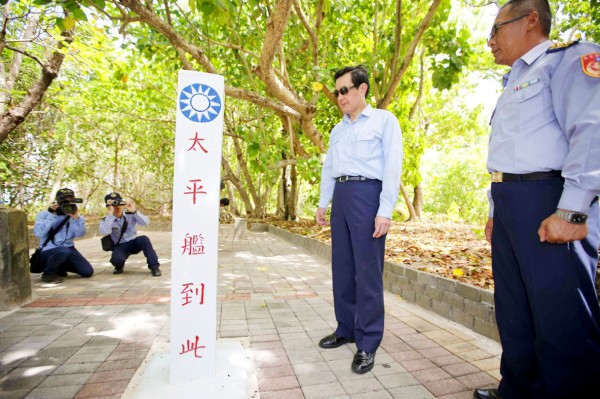《TAIPEI TIMES 焦點》Ma touts peace on Taiping Island visit
SOVEREIGNTY: The president reiterated the nation’s claim over Itu Aba Island, while expounding on a roadmap to settle disputes in the South China Sea
By Stacy Hsu / Staff reporter
President Ma Ying-jeou (馬英九), ignoring US criticism, yesterday visited Itu Aba Island (Taiping Island, 太平島) in the South China Sea, where he reiterated the Republic of China’s (ROC) sovereignty over the land mass and its status as an island.
Accompanied by government officials and academics, Ma boarded the presidential plane at the Songshan Air Force Base in Taipei, flying to Pingtung County early yesterday morning, before transferring to a C-130 transport aircraft bound for Itu Aba.
Ma arrived at about 11am on Itu Aba, the largest island in the Spratly Islands (Nansha Islands, 南沙群島), which has been administered by Taiwan since 1956 and is also claimed by China, the Philippines and Vietnam.
Ma is the second ROC president to set foot on the island, after then-president Chen Shui-bian (陳水扁), who visited it on Feb. 2, 2008.
After meeting with staff stationed on the island, Ma delivered a speech in front of a memorial tablet bearing a message from him that read: “Peace in the South China Sea and our national territory secure forever.”
“I am very happy to be here today, before the Lunar New Year, on Taiping Island, with all of you stationed on the Nansha Islands, which are part of the southern territories of the ROC,” Ma said.
Ma said the disputed islands in the South China Sea were first discovered, named and used by the Chinese in the 1st century BC, and the ROC government later published maps of the islands in 1935 and 1947.
The Spratly Islands, the Paracel Islands (Xisha Islands, 西沙群島), the Macclesfield Bank (Zhongsha Islands, 中沙群島), and Pratas Islands (Dongsha Islands, 東沙群島) are all an inherent part of the ROC’s territory and waters, whether from the perspective of history, geography, or international law, Ma said.
“To resolve disputes in the South China Sea... on May 26, 2015, I put forth the South China Sea Peace Initiative, calling on all parties concerned to reduce tensions, increase dialogue, abide by international law, uphold freedom of navigation and overflight, maintain peace and stability in the South China Sea, and settle disputes peacefully,” Ma said.
In an effort to flesh out the initiative, Ma yesterday proposed a “South China Sea Peace Initiative Roadmap,” based on “three yeses and three noes”: yes to cooperation, no to confrontation; yes to sharing, no to monopolization; and yes to pragmatism, no to intransigence.
Ma said the roadmap offers a viable path, two essential elaborations and three phases of progress.
“The viable path consists of shelving disputes, integrated planning and zonal development,” he said.
The two essential elaborations call for concerned parties to be included in the initiative’s consultation mechanism, and to engage in cooperation and negotiations, Ma said, adding that the mechanism should not impede the formation of a final agreement on the territorial disputes.
The three phases of progress refer to short, medium and long-term planning, with the government working to transform Taiping into an island for peace and rescue operations, as well as an ecologically friendly and low-carbon island, the president said.
Ma rejected the Philippines’ categorization of Itu Aba as a “rock,” saying the island has sufficient natural vegetation thanks to its favorable soil and water quality.
“Such statements [by the Philippines] have no basis in either science or fact; they are totally wrong. The economic, environmental and cultural realms all provide sufficient evidence to show that the island has — and has had for more than 100 years — ample resources to be self-sufficient,” Ma said.
The island is home to 106 indigenous plant species, several animal species, a variety of sources of food, and a 10-bed hospital manned by two physicians, a dentist and three nurses, he said.
“All this evidence fully demonstrates that Taiping Island can sustain human habitation and an economic life of its own. It is not a rock, but an island, and meets the criteria for an island as specified in Article 121 of the UN Convention on the Law of the Sea,” he added.
Ma arrived back in Taipei at about 5:40pm.
新聞來源:TAIPEI TIMES














